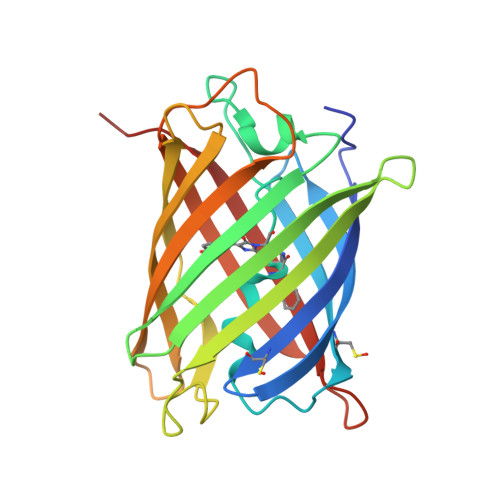zFP538, a yellow-fluorescent protein from Zoanthus, contains a novel three-ring chromophore.
Remington, S.J., Wachter, R.M., Yarbrough, D.K., Branchaud, B., Anderson, D.C., Kallio, K., Lukyanov, K.A.(2005) Biochemistry 44: 202-212
- PubMed: 15628861
- DOI: https://doi.org/10.1021/bi048383r
- Primary Citation of Related Structures:
1XA9, 1XAE - PubMed Abstract:
Crystal structures of the tetrameric yellow-fluorescent protein zFP538 from the button polyp Zoanthus sp. and a green-emitting mutant (K66M) are presented. The atomic models have been refined at 2.7 and 2.5 A resolution, with final crystallographic R factors of 0.206 (R(free) = 0.255) and 0.190 (R(free) = 0.295), respectively, and have excellent stereochemistry. The fold of the protomer is very similar to that of green (GFP) and red (DsRed) fluorescent proteins; however, evidence from crystallography and mass spectrometry suggests that zFP538 contains a three-ring chromophore derived from that of GFP. The yellow-emitting species (lambda(em)(max) = 538 nm) is proposed to result from a transimination reaction in which a transiently appearing DsRed-like acylimine is attacked by the terminal amino group of lysine 66 to form a new six-membered ring, cleaving the polypeptide backbone at the 65-66 position. This extends the chromophore conjugation by an additional double bond compared to GFP, lowering the absorption and emission frequencies. Substitution of lysine 66 with aspartate or glutamate partially converts zFP538 into a red-fluorescent protein, providing additional support for an acylimine intermediate. The diverse and unexpected roles of the side chain at position 66 give new insight into the chemistry of chromophore maturation in the extended family of GFP-like proteins.
Organizational Affiliation:
Institute of Molecular Biology, Department of Physics, University of Oregon, Eugene, Oregon 97403-1229, USA. jremington@uoxray.uoregon.edu


















